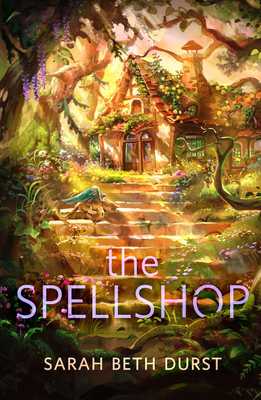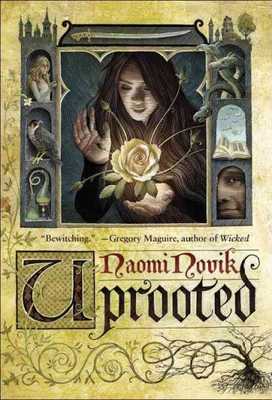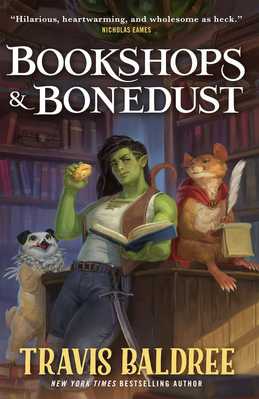Okay, strap yourselves in. In this review, we’re journeying Into the Woods, deep under the dark canopies where strange things sleep, and ancient entities watch for errant travelers. It is a dangerous path, and we are likely to be changed before we reach the other side, if we reach it at all!

Just kidding, we’re reviewing Uprooted, the Dark Fantasy novel by author Naomi Novik. Although, you could be forgiven for mixing those two up, with how lengthy and oftentimes meandering the story flows. As per usual, a big old SPOILER WARNING for those of you who haven’t read the book – go no further! Or, read on if you like; I’m not your mom.
Also, a brief Content Warning: Body Horror, mentions of rape and violence.
Allright, let’s get right into things: I found this book….frustrating. There are a load of good things in here, elements that I enjoyed, and some genuinely creative descriptions that really stuck in my head. But, there were some MASSIVE problems for me, which really soured the reading experience. First up…
The Story
The story begins as a slow burn, described in a first-person narrative by our heroine Agnieszka, a pastoral teenager living in a valley on the edge of the medieval fantasy kingdom to which she belongs. The people of her village live constantly under the threat of the nearby wood, which is evidently a nightmare factory of giant insects and beasts, fast-growing evil trees, and a nameless malevolence that can infect people with a contagious madness. Their defense against this ever-present, body-horror carnival? One grumpy magic boy, living in a tower at the edge of the valley.
The local lord, a wizard that is known to the villagers simply as “The Dragon”, is spoken of with almost as much hugh and fear as the wood, and we learn the reason for this almost immediately. Disdaining to spend any more than the bare minimum of time outside his tower, so little is known about their wizard, except for his demand for very specific tribute. Every ten years, he chooses a village girl from those born in another, specific year, and forces them to come with him to his tower.
Okay, I know what you’re thinking already – classic fairy tail dragon disguised as a wizard, OR creepy, semi-immortal old man using his lordship for unsavory purposes, right?

Wrong, but we’ll get there later.
Anyway, as you can probably guess, Agnieszka is one of those “dragon-born” village girls. All of the girls who are potentially going to be chosen live in a sort of limbo their entire lives, their parents and peers slowly ‘mourning’ them, in a manner, and keeping them at arm’s length. This is messed up, for a number of reasons, but hey, it’s a dark fairy tale. At any rate, Agnieszka (that’s tough to keep typing, so I’m going to call her “Angie”) is pretty certain she won’t be chosen, as is the rest of her village. The reason for this is the existence of her childhood bestie, Kasia. Kasia is everything Angie is not: Tall, beautiful, clean and neat, possessing many practical skills, etc etc – while Agnieszka’s main claim to fame is that she can dirty her clothes at record speed, and find edible berries and mushrooms in the forest whenever she goes looking (hey, that is pretty useful, come to think of it…)
So when the Dragon (who it turns out is very young and handsome, with apparently only some crow’s feet to indicate his advanced age) shows up at the ceremony and picks Angieszka, the bottom falls out of everyone’s world.
From here, the story starts percolating into a “magician’s apprentice” montage, with a number of stumbling blocks along the way as Angie, lacking any context or explanations whatsoever, misunderstands his intentions and instructions; while the wizard (Sarkan, we later learn is his name), remains startlingly oblivious to how intimidating, and then rude he comes across. Slowly, verrrry slooowly, the story picks up steam, and we get some genuinely good odd-couple moments with the two of them doing magic together. Angie has a more intuitive way of casting spells to Sarkan’s rigid, methodical approach, and this enrages him at first, and confuses him later.
The story goes on from there, giving us glimpses of the wider world, the country Angie lives in, small hints (in hindsight) about the true nature of the wood, and a parade of not particularly likable characters. We meet a gallant prince (who makes the leap to attempted rapist in the span of two pages), a conniving court-wizard, and eventually, an entire royal palace’s worth of insufferable nobles. Angie goes into the woods a number of times (and at least once under duress) to save people taken by it, and narrowly escapes each time. She visits the royal city, and unwillingly briefly tries to play politics. She discovers that the corruption of the wood is somehow present in the castle as well, and before she can stop it, most of the named characters in the city are dead or dead-set on killing her, and she’s running for her life with Kasia and two surviving royal children back towards the valley…it all gets very messy from here.
By the end of the book, I was just READY for it to be done. The story seemed to drag on for an incredibly long time. There was a lot to read, at 435 pages, and to be honest, the book probably should have been a third or more shorter. A big part of this was…
The Pacing
Uprooted seemed all over the place. After setting the initial scene, it inched by, giving us only glimpses of what was to come as Angie started learning magic and proving herself in key moments. But then, The Palace Chapters…..
Everything starts going full-throttle in the second half of the book. Within the span of a chapter or two, the body count starts piling higher than the canopy of a heart tree, and it doesn’t stop until the end. Tension is important in storytelling, and ramping it up as the tale goes on is standard practice, but the stakes went through the roof far too quickly, and there never seemed to be much time for either us or the characters to catch a breather. I suspect a lot of this had to do with how oppressively powerful the evil forest was – and how it always seemed to be several steps ahead of everyone else, no matter what.
I’m sure this wasn’t intentional, but it felt like every time Angie (with or without help) pulled off some miraculous accomplishment – the wood had three contingency plans that the characters eventually stumble upon that undoes everything. As an example, the big turning point in the novel involved rescuing the kingdom’s Queen from the wood, after being trapped there for a whopping twenty years – she’s got to be compost at this point, right? And yet, when Angie, Sarkan and company brave the woods to actually find her, they manage it! What’s more, they somehow purge the corruption, leaving the Queen in a sort of magical fugue state (hey, spending two decades as mulch will do that to ya). So it’s clear there’s something still wrong with her, but the book beats us over the head with repeated demonstrations that the specific corruption of the wood is GONE.
Aaaaand then about five chapters and hundreds of bodies later, we get this gem:
“My face ached as if she’d struck me, with a sharp hollow pressure above the bridge of my nose, familiar. ‘The Wood’, I said out loud.
‘What?’ Sarkan said.
‘The Wood,’ I said. ‘The Wood is in her.’ Every spell we’d cast, every purging, the holy relics, every trial: none of them mattered. I was suddenly sure. That had been the Wood looking back at me. The Wood had found a way to hide.”
If Uprooted were a game, this is the point where I would have flipped the table and walked away. I almost closed the book then and there, but it was so close to the end that I pushed on. In the end, the heroes actually cannot defeat the wood by fighting it, and…I guess that was the point?

Instead, Angie gets tossed into a heart tree, and gets a thesaurus-sized lore dump on the history of the wood. She learns that there was once an entire race of immortal tree-people living peacefully in the woods. The tree-people and a previous kingdom of humans once lived together in (relative) harmony, and that one of the tree-people had married the human king. However, the humans grew scared of the tree-people, and the king’s son (presumably from a previous marriage) had the tree-queen sealed up inside her husband’s tomb. So, naturally, she broke out, rejoined her people, and lived happily ever after…
Just kidding, the tree-people decided to all go into permanent hibernation and become full-trees, and the tree-queen arrived too late, and too full of hatred to join them. She swore eternal vengeance on mankind and, boom, evil woods.
Angie learns all of this, finds her way out of the heart tree, and Power of Love’s her way to a happy-ish ending for everyone – yay! The entire experience felt jarring, and left me exhausted. But the thing that really made it hard to enjoy this book was…
The Characters
I could count the number of people I cared about in this story on one hand. So many of the people we are introduced to either die before we learn anything of consequence about them, or turn out to be total jerkwads. Outside of Angie and Kasia, you’ve got:
- Jerkwad the Magnificent, caster of spells and shade
- The Evil Faceless Forest that just needs a hug
- Prince Rapey mcBadDecisions
- Pe’nis En’vious, the realm’s second-best Wizard
- Badass Blacksmithing Witch, who spent a century forging a sword to kill the wood (it doesn’t work)
- Other Prince(™), killed off-screen a few pages after his only lines
And a litany of minor characters that don’t really get much time to develop in any interesting way. In the end, there was a good story in here somewhere, but it was buried deep under (mostly) bland or unlikeable characters, twists that undermined notable moments, and a tendency to tell when it should have shown. Uprooted does a few things right, and there’s a devious creativity in this earlier work of Novik’s that I recognize from her more recent Scholomance series. But I’m just glad to be out of the woods, and I don’t think I’ll be going back.

















